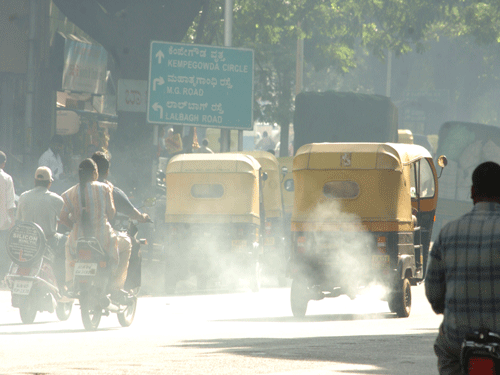
The City’s air pollution - especially Particulate Matter (PM10) - exceeds recommended standards in all wards. The major contributors are vehicles, dust from paved roads and soil, reveals a study on the effects of air pollution on cardiovascular disease (CVD).
A research led by Dr Anitha Chinnaswamy, academic researcher and lecturer in Information Systems/IT Management under the supervision of Prof Ian Marshall, deputy vice-chancellor, both from Coventry University, UK, shows that levels of PM10 were of concern with all the 198 wards having either high or critical levels of pollution.
The research confirms that 50 per cent of PM10 is a result of paved road and soil dust and 19 per cent due to vehicles. Vehicular pollution, on the other hand, contributes to 50 per cent of PM2.5, which is more hazardous to health, the findings said. PM consists of aerosols, smoke, fumes, dust, ash and pollen. While PM2.5 are particles smaller than 2.5 micrometers, PM10 is particulate matter up to 10 micrometres in size.
In certain wards, PM10 exceeded up to three times the recommended permissible limit of 60 microgram/m3. To analyse the effects of air pollutants on CVD in Bengaluru, the researchers obtained in excess of one million death records and found that the CVD deaths contributed to almost 40 per cent of total mortality.
Sulphur Dioxide (SO2), however, was found to be well under permissible limits, due to the various measures taken by the government such as reduction of sulphur content in diesel fuel and wider use of liquefied petroleum gas (LPG), instead of coal as domestic fuel.
As part of the research, an Environmental Health Information System Model (ENVHIS) based on Geographic Information System (GIS) was designed specifically to conduct a spatiotemporal analysis of the effects of air pollution on CVD. With support from various authorities such as BBMP, KSPCB (Karnataka State Pollution Control Board) and Transport department, data including demographic, air pollution data, vehicular data and mortality data was obtained and used for analysis.
“Particulate matter can penetrate the respiratory tract initially, by entering the nasal passages and into the alveoli. Due to their excessive penetrability, they then enter deep into the lungs and are deposited within the tracheobronchial tree, respiratory bronchioles and the alveoli where gas exchange occurs. The particulates then enter the bloodstream resulting in significant health problems,” said Chinnaswamy.
It took around three years to conduct this research and publish the results. An ex-student of RV College of Engineering and an Associate Fellow of the UK Higher Education Academy, Chinnaswamy said further research will be carried out on various aspects of air pollution and its effects on the health of Bengalureans.Chinnaswamy said that the main objective was to assess exposure to pollution and its role in heart diseases.
She said that it is vital to develop intervention and awareness policies that will ultimately prevent millions of deaths and enhance overall quality of life.